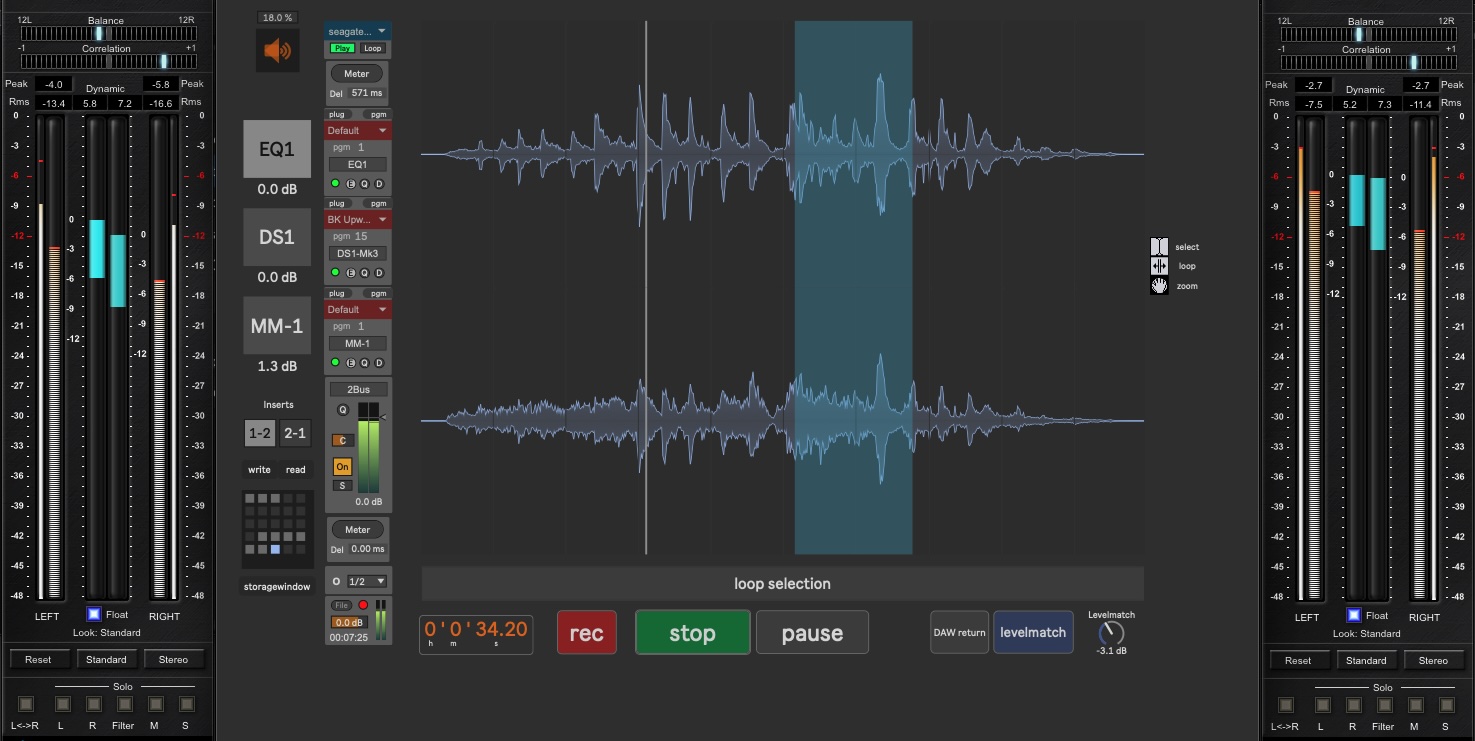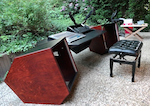Mastering
Even if a recording is well mixed, the decisive difference comes with the "master" (actually actually referred to as the “pre-master"). The mastering process (e.g. for vinyl or audio CD) is carried out with the stereo signal of the final mix. At first, potential problems or damages are corrected, i.e., small pops or offsets and "bumps" will be localized and then repaired or removed. Next, surgical equalizing is applied to correct frequency masking - this can occur quite frequently between the bass drum and bass, for example - and lastly, a loudness and dynamic range adjustment and a final equalization is applied to the entire material, preferably to make it appear more consistent.
The question that keeps coming up is: "ITB" or "OTB"? (Software or Hardware)
ITB = "in the box" = digital mixing and summing within the computer.
OTB = "out the box" = analog mixing and summing

Actually a strange question, because it draws a line that no longer exists at all and can only be (easily) implemented on the ITB side - "The Box" after all stands for the Computer. Nowadays 99.n% of the music is recorded with computers or digital devices and mixed in the computer, i.e. the boundary to digitalization has already fallen with the recording. Even at 100% analog post processing, a DA and an AD conversion will be added again. For Room Simulation or Reverbs "everyone" uses exclusively digital processors (strictly speaking they are "PlugIns" with their own computer). In short: digital has become inevitable - and after all, the finished result is supposed to be in digitalized format. More sadly, all the analog peripherals have already largely disappeared and the wear and tear material (e.g. tapes) is almost unaffordable. I no longer know anyone who uses tapes for recording (nor anyone who doesn't use PlugIns in the computer). I still know of some studios with large mastering tape machines, but they have been used for years only on extremely rare occasions. "Full analog" has been long since in the realm of "enthusiasm".
"OTB" is not synonymous with "all-analog". It refers exclusively to not using the "last" (digital) buss in the DAW any more as a summing and mastering buss, but rather using analog summing of the DAW's individual outputs and routing the resulting stereo signal into an analog Mastering chain. This chain then consists of Equalizers, Compressors, a Stereo Field Editor and a Limiter, for example. Since "Mastering" is also "Mixing", Parallel Mix, Mid/Side switching, individual gain adjustment of the connected analog processors and also interconnections are further available (e.g., instead of a) Compressor; b) EQ; ... to a) EQ; b) Compressor; ...). If you want to use A/B monitoring, you will also need a loudness compensation in the monitoring path. Such a device is called a "Transfer Console" in hardware. At the very end the (stereo) sum is returned to the DAW (for recording). Since the "DAW coherence problems" have been solved, the analog summing is neglected more and more, because it only produces a true improvement in very rare cases. For more strongly colored results, the RND 5057 Orbit breaks new ground with its additional -6dB output - that would certainly be worth a try (for Rock and the like).
The State of Affairs
PlugIns have evolved enormously over the last 20 years and even small computers are now powerful enough to handle a large amount of PlugIns without the need for additional hardware. It's possible to realize entire productions ITB without any "negative aspects" being audible. PlugIns of emulated hardware may not sound 100% identical to their analog counterparts, but they are getting closer to this goal and already possess "their own qualities".  There are even some advantages to PlugIns - the most obvious being the ability to save and recall settings and to use as many PlugIns of the same type as you like in your project. Particularly good at adding important functions to PlugIns is the PlugIn Alliance - for me the current leading provider of emulated hardware (channel strips, equalizers, compressors).You can see it well in the example of the cover picture: These are emulations of the processors SPL PQ, an impressive Equalizer and the Compressor SPL Iron, both quite recent devices that were quickly seen in many prestigious mastering studios- and accepted with enthusiasm. However, the PlugIns reveal four "devices", not two. Both processors have been enhanced by tremendously useful and helpful "additional processors". The parameters: In- and Output Gain (with meter), Mono Maker, Filter, Stereo Width, THD, Parallel Mix, M/S- Circuit and TMT (© PlugIn Alliance). The extensions are indeed extremely useful, but they do not necessarily have to be activated and can be removed visually.
There are even some advantages to PlugIns - the most obvious being the ability to save and recall settings and to use as many PlugIns of the same type as you like in your project. Particularly good at adding important functions to PlugIns is the PlugIn Alliance - for me the current leading provider of emulated hardware (channel strips, equalizers, compressors).You can see it well in the example of the cover picture: These are emulations of the processors SPL PQ, an impressive Equalizer and the Compressor SPL Iron, both quite recent devices that were quickly seen in many prestigious mastering studios- and accepted with enthusiasm. However, the PlugIns reveal four "devices", not two. Both processors have been enhanced by tremendously useful and helpful "additional processors". The parameters: In- and Output Gain (with meter), Mono Maker, Filter, Stereo Width, THD, Parallel Mix, M/S- Circuit and TMT (© PlugIn Alliance). The extensions are indeed extremely useful, but they do not necessarily have to be activated and can be removed visually.
It's truly impressive what PlugIns (can) offer these days, and the plugins open up the possibility - especially for those who don't have access to analog processors - to get to grips with the workings of this category of processors, which are very pricey in hardware terms, and to enjoy their blessings (at least to a certain degree). An expedited learning process is also provided by the included presets. However, you do not learn the reason why the knobs and switches are in their positions - so it is more a conditioning to the PlugIn, the settings are " catalogued " and categorized by pondering the listening impression of the presets. You can get pretty far with it, but in the end you don't know why you got that far. The actual craft is quickly faded out or even completely disregarded. If no satisfactory solution is found with presets, another plugin is then accessed (too) quickly.
This is a great " risk " of the PlugIns for ambitious beginning sound engineers, because the offer is almost boundless and one will rather get bogged down in this offering, than learning how the existing problem can be solved in terms of sound engineering. Availability in abundance (redundancy) always introduces degeneration. In many cases, working with PlugIns is not that different from "convenience cooking", where prepared food is mainly just warmed up. In the course of the work, the cooks (or sound engineers) hardly notice that they are only reheating, due to the employment. It is mainly goal-oriented and what is important is how it will taste to the customers. The actual creative process moves into the background and the whole affair - not the result - moves into a rather soulless activity. The virtuality of the PlugIns further supports this.
Of course, all this is especially applicable to the new generation - trained sound engineers will still be able to apply their knowledge and possibly enjoy both the result and the time saved. The outcomes of ITB and OTB are actually becoming increasingly difficult to distinguish. The differences are sometimes so subtle that top equipment and acoustically treated rooms might be a condition for perceiving the differences.
We are in a state of movement, and this movement is clearly heading in the direction of ITB. The customers in particular - I'll call them listeners from now on - probably won't notice this process at all, and most of them don't even have the acoustic environment (in their living rooms) to make distinctions - nor are they familiar with the equipment. Thus, the actual problem is mainly on the producer's side, particularly with the newcomers who have already grown up with plugins.
Another issue: music no longer has the durability of the old days, and it is used (also through the conditioning of the film industry) more as an atmospheric accompaniment. The way of listening has become something different, more "external". These are characteristics of an industrialization which leads to consumerism and ritualized behavior - and rituals make us forget about their own origins due to their self-centeredness - Ludwig Feuerbach acknowledged this already 180 years ago.
Differences between Software and Hardware

So what's the deal with the hardware? First of all, a powerful " regulative " must be mentioned when choosing ITB/OTB, because the expense for the hardware of the mastering segment is striking: SPL Equalizer and Compressor of the above shown PlugIns already charge more than 12,000 Euros in hardware version alone. They also require some wiring and, from time to time, a service in the workshop. Furthermore, they have to be connected to additional hardware. What would be required at least corresponds to the additional "devices" which Brainworx has added to the SPL PlugIns.
Analog processors also are pretty weighty, so they demand a permanent location (and acoustical improvement of the space) including good speakers. Hence, they introduce an entire chain reaction in terms of demands - and I don't know of any studio that only has one equalizer and one compressor. For the vast majority of the (significantly growing) fraction of people using headphones for mastering as well, it is likely that financial aspects have been the determining factor from the very beginning, even though some better-known mastering engineers have switched to ITB with considerable publicity.
Anyone who is experienced with both hardware and PlugIns will at least be able to confirm the statement that the hardware just performs the legendary μ (mu) better. It delivers an impression that is more "personal". I also can agree with this, but I regularly suffer from the fact that this imprint is significantly reduced on the finished master and is therefore more difficult to be recognized.
The PlugIn already is a reproduction, thus already "on the other side" - the one of the already recorded music - while the analog processor is taking up the place of the (still to be recorded) instrument. No matter how good the recording may be, a recorded instrument appears in a different acoustic "setup". It has become the sonic image of the instrument not until it is recorded. Something similar happens with analog processors, while the plugins don't undergo this transformation, because they are an image from the beginning. This is a difficult detail to be aware of when comparing plugins with hardware. A comparison can therefore only be done through the recordings, not prior to the recording on the console, by switching back and forth.
Pleasure
This is precisely the point where a "game-changing" aspect of the analog outboard has moved into focus. Tweaking analog processors, unlike plugins, is more like playing an instrument. You can make the hardware sound with all of its components - and you also hear what can't be heard on the recording as a whole. To me it seems similar to the difference between a grand piano and a sampled grand piano. The process of working (playing) is totally different. The sound is not retrieved (PlugIn or sampled), but "achieved". This process has more to do with inspiration and real experience than processing on a virtual level.
Here is the biggest difference, for me, and it changes the whole creation or creative process. It is very exciting to listen to how, for example, the transformers and adjusted frequencies react to subtle changes in the input volume, how the components of the unit "work" and bring out their sweet spots. I haven't experienced this with any PlugIn so far - but they are getting closer.
I therefore suggest that the question "ITB or OTB?" is more precisely defined as:
"What external Processor or assemblies will give me (back) the fractions while working that I am (still) missing when completely processing ITB?"
The question about the required analog processor(s) is in any case rather my question, or my road - already because I do not work full time, commercially, in the studio business in dozens of different genres (i.e.: the, to me not feasible financing of a more extensive hardware), and also because I simply feel more comfortable with less hardware. I've been very lucky with the insight opportunities along the way, partly because I've had my faith in the Metric Halo company from the beginning. The difference to other interfaces is that they come with their own CPU and the control software not only includes channelstrip, gate, compressor, limiter, etc., but also "building blocks" with which you can assemble your own processors. And now, since the MkIV version of ULN-8 and LIO-8, finally the Round-Trip Latency is so short at 18 samples, that it is possible to work with it in a similar way as you would with analog equipment. (In fact, this aspect is even more important to me when working "live").
And there was something else that was striking from the beginning: the MH PlugIns sound and feel more like hardware, really very different from the AU and VST PlugIns. I think it's due to the higher "processor proximity" (and Assembler?) and the internal 80bit processing range - but that's just my guess.
In the same area might also be the main weakness of AU or VST PlugIns, because it takes "more corners" and the Operating System of the Computer to reach the CPU. I also think that many VST EQ PlugIns are far too much alike and only reveal their differences at more extreme settings. Unfortunately, it is at such settings that the PlugIns are significantly weaker than their analog counterparts. Another weak point, which probably also has to do with the similarity, is the way of implementing an EQ. In emulations, so-called spikes are used for the characteristics, which influence the overtone behavior and thus come closer to the character of the analog role model. It was an important step, but not yet "the solution". In the digital world in addition exists the "fight" against the Nyquist frequency - I think this is especially a problem in the "air-band", i.e. in the very high frequencies, and it might be partly responsible for the harshness and the "over-powering" of high frequencies in the AU and VST PlugIns. I expect the Nyquist frequency problem is the (main?) reason for using oversampling in high-quality digital processors.
Ways of Cognition
Just 20 years ago the main problem was the summing bus and I conducted many experiments with analog summing units, especially from Dangerous Music, but also passive buses (e.g. Folcrom) with Telefunken V672 cassettes set as a makeup amps thereafter. Analog was clearly better than digital in every combination, yet the promised "console feel" wouldn't take over. The "trick" with analog summing was feeding the 8 channels from individual outputs into the summing unit's 8 inputs at a level that would have produced clipping in the interface's sum (when summed). The analog summing bus, though, lowers the level by about 35dB, hence the gain makeup behind it, but now it was done somewhat smaller than +35dB. About the year 2008, however, the summing problem was solved from a different direction: the software-related DAW coherence problems have been overcome. The differences melted away - in my opinion it even sounded a bit better from the MH audio interface - and finally as well from the DAW, in the audio editor.
Thus, the first phase of my "analog apprentice" (in analog summation) was at an interesting time, because it was precisely when a lot of things happened to change. The (analog) lessons I have learned can be summed up very simple: "Analog summing (OTB) is always an interaction of components, since they include a change in impedances. This circumstance alone does not allow any fundamental statement to be made about the quality of analog summing as such."
Changing the impedances can cause a gamble of dice easily and this can, for example, cause some devices to not sound after other devices. In the analog world, there are some "invisible" points that may have a big impact. It could even begin with the phase in the power connection. Impedances are most certainly a second priority…
Starting in 2013, I assembled my analog Mastering Chain, which I like very much - but which I hardly ever use. Working with it gave me a previously unknown joy - so far I had rather "suffered" with (digitally executed) audio engineering tasks. Above all, however, I wanted to explore the differences between the analog and the digital more closely and therefore wanted to have an analog counterpart permanently available. However, I did try a couple of things and I believe I'm on a good track.
To begin with, my two "important" or most authoritative Equalizers had impressed me for different reasons. The Great River MAQ-2NV due to its versatility and huge tone - which is probably due to its transformers - plus the way it responds to incoming level changes in its color. Absolutely exciting. The other EQ, the BAX made by Dangerous Music, which I have most of the time as the final EQ in the chain, is convincing with its phase linearity and the smooth shaping with which it binds the overall sound in a "very classy" way. I have also compared the Bax with the UAD Bax PlugIn and that what touches me most on the analog Bax, I was unable to find in the PlugIn.
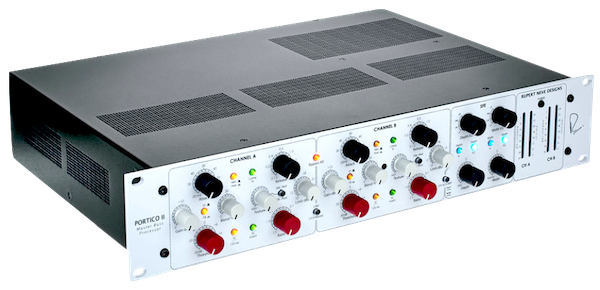
The most powerful tweak among my 19-inch processors, however, is created by the RND Portico II Master Buss Processor. It is a parallel buss with a terrific compressor, limiter, stereo field editor and the Neve-Silk circuitry. The 72V rails and large transformers seem to have their effect as well. The MBP changes the incoming signals strongly (for the better) even without actively noticing the components involved! It can actually do everything, from "Classical" to "Metal".
This is where I found what I was originally looking for in the summing - and something more! Keywords: transparency, plasticity, spatial staggering, analog appearance. Actually, I could imagine that this might be the only analog Outboard at some point, since it has everything I was looking for - but haven't yet actually tried it in practice. As I was interested, I had taken the Master Buss Processor and the Bax EQ to a live sound reinforcement and put both in pre position of the NEXO PA. The result was stunning (the BAX also being very "attractive"). The MBP made a huge difference that I couldn't even come close to by using Plug-Ins.
One other device in my analog Mastering Chain that I actually miss in the digital workflow is my Transfer Console from SPL. While it doesn't leave any sonic imprint, it is the key to getting the connected Processors in proper balance, and it makes the process very enjoyable. All volume levels in one place. A/B listening with Loudness Compensation. Another quality. However, if the rest of the analog processors are no longer present in the Mastering Chain, there will be no way around coding something that is comparable.

All in One
Studer Console 961 (OTB)
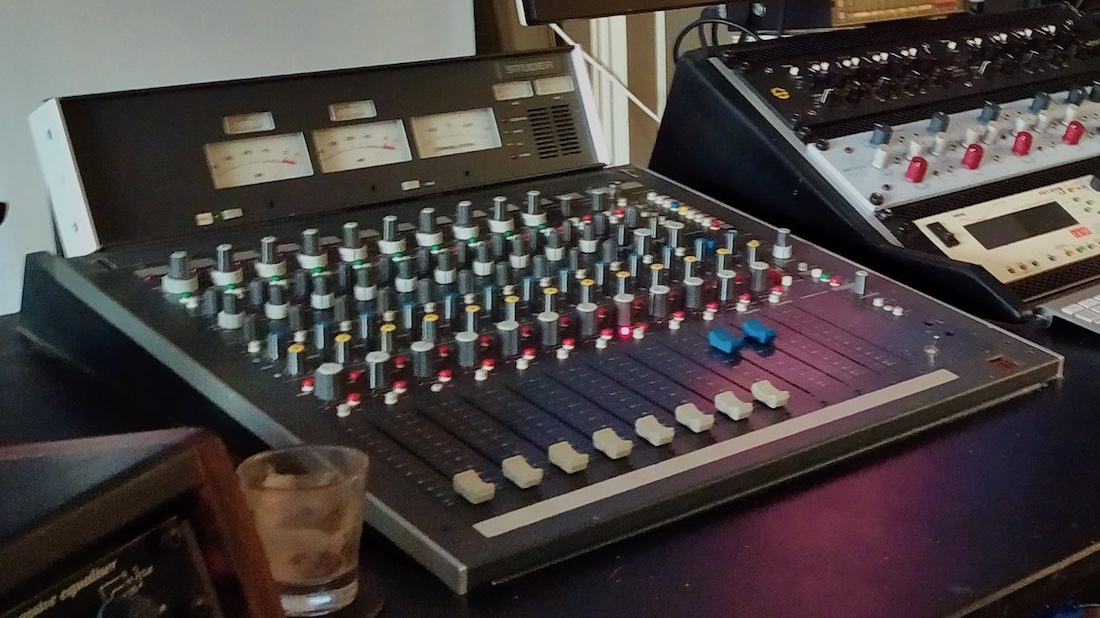
A good console is a nice "all in one“ solution as well, e.g. the Studer 96x series consoles, which were produced from 1985 to 2007. Of course, it's not explicitly made for Mastering, but actually you can do pretty much everything with it. It also has a buss for additional external processors to further enhance its specialization. A rather historical way to go, but if you come across it, it's worth a consideration. It takes significantly more learning of how things work than Ozone or PlugIns with presets, but you'll be rewarded. ... Even as a child I felt addressed by "Heracles at the crossroads" (gr. mythology).
Many decisions are based on personal preferences and taste. I like "these older" devices, just as I prefer historical recording methods. Maximization is not my cup of tea - the maximum number of microphones, maximum volume and maximum isolation of instruments from each other, also pretty much change the process of performing for the musicians. It's the "perfect illumination" and everything that disturbs is made up (photoshopped). To my sound imagination this is mostly too tidy, too artificial, posturing unnaturally and occasionally even too sterile and retort-like. I also don't like excessive "microscopization" - that is, for example, if the guitar sounds as if it were 30m large. These "fashions" have also had a very negative effect on live music because audiences can no longer align themselves to the sound and have become conditioned to the "Photoshopped sound".
Ozone (ITB)
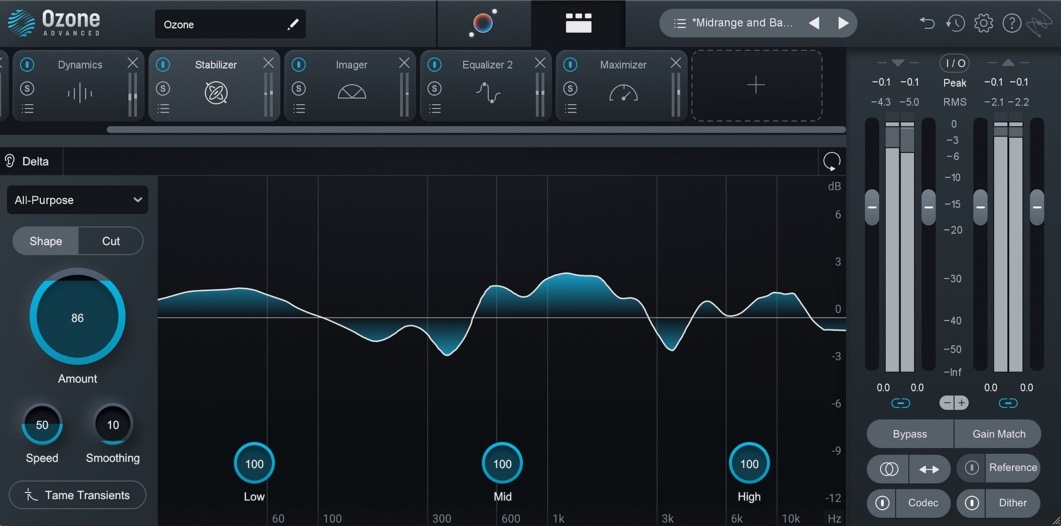
Ozone from Izotope is perhaps the most common "all in one" solution for mastering. I was using this software regularly in the past, but meanwhile I updated several times " due to loyalty" - I don't like this software that much. There are many automated aids - Izotope is "way ahead" in that respect - their sonic ideal seems to be clearly in popular (industrial) music - which is too far from my sonic imagination. Also the style of operation does not correspond to what I am looking for. It's more of a "mastering factory" in my eyes - and too focused on volume for my taste.
Nevertheless, I have learned quite a bit by using Ozone - and it is possible to work with it. The interface is very well done, kept simple and appealing - and since Ozone 10 it even tempts me to give it a try again. It is a virtual master bus and external PlugIns can also be inserted.
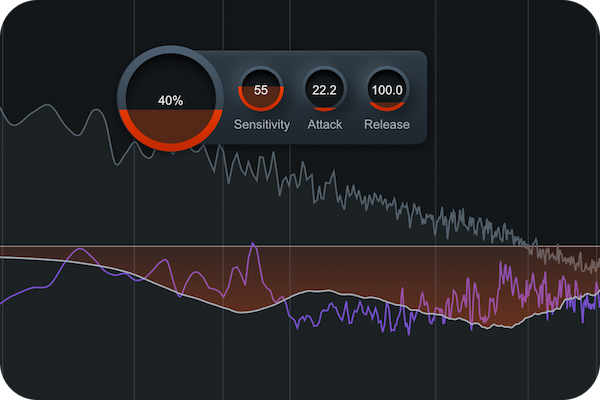 I was even more enthusiastic about Neutron, the equalizer plugin from Izotope. Especially when learning EQ-ing it is helpful because it automatically suggests very well boost or cut frequencies (even in complex soundfiles). Since the new version 4 it also has an "Unmask Module" (picture) to attenuate masking frequencies - one of the more difficult operations that can still be necessary in mastering.
I was even more enthusiastic about Neutron, the equalizer plugin from Izotope. Especially when learning EQ-ing it is helpful because it automatically suggests very well boost or cut frequencies (even in complex soundfiles). Since the new version 4 it also has an "Unmask Module" (picture) to attenuate masking frequencies - one of the more difficult operations that can still be necessary in mastering.
Brainworx bx_mastering studio FREEWARE (ITB)
 Brainworx knocked it out of the park! This is probably the best possible form of advertising, simply because it is consistently positive: “useful” mastering software that is available for free download!
Brainworx knocked it out of the park! This is probably the best possible form of advertising, simply because it is consistently positive: “useful” mastering software that is available for free download!
The software is kept simple and consists essentially of an EQ (“Tone”) with 9 parameters and a THD Saturator/Compressor/DeEsser/Limiter with 10 parameters. In addition, it includes some of the features that are also provided as a “second device” with many bx plug-ins: input and output controls, “Foundation,” “Stereo Enhance,” and Mono Maker (which is part of the Equalizer, though).
So everything is very clear and simple – which I think is a good approach in this case. How do you create good mastering with it? For many non-sound engineers in particular, the settings for EQ, Compressor, Limiter, etc. can be overwhelming, and this is where this software really shines: when loading the audio file, you'll notice that it takes a little longer for the file to be processed. My guess is that an analysis process is performed here that fixes exactly those problems (masking, phase cancellations, etc.) that prevent the file from being played back loud and clear enough in the end. And these things can only be fixed manually with the appropriate knowledge. So it's pretty ideal for musicians who want to get their music into a presentable form. A plain computer is all you need.
The loaded audio file (which must be in .wav format in version 1.0.0 / on Apple, this can be created using iTunes' “convert” function) can be listened to with 11 preset settings in order to select the most suitable one. You can then “tweak” (i.e., carefully change selected parameters) and achieve amazingly good results. You can save (and delete) your own presets. I'm impressed. The loaded audio file (which must be in .wav format in version 1.0.0 / on Apple, this can be created using iTunes' “convert” function) can be listened to with 11 preset settings in order to select the most suitable one. You can then “tweak” (i.e., carefully change selected parameters) and achieve amazingly good results. You can save (and delete) your own presets. I'm impressed. Kudos!
My MAX 2-Bus (Autumn 2025)
I wanted to know, so I started programming my own mastering software in MAX. Since I own a Weiss EQ1 Dyn/LP as physical equipment and the Weiss DS 1-Mk3 (compressor/de-esser/limiter) as software, and since Weiss processors have long been a trusted reference for me, I am initially using the Weiss-Software PlugIns of Softube for this project.
The mastering software is based on a 2-bus channel strip with (currently) three VST inserts for processors and two VST meter strips—one for input and one for output. VST 1 (EQ) and VST 2 ( Compressor) can be switched in their order. It has a “Loudness Compensation” switch and dial for comparing the unprocessed and processed material. You can also zoom in on the waveform display. I have been pleasantly surprised with both the handling and the results of my 2-Bus and am very satisfied so far—I had not expected this.
The 2-bus (or channel strip) is based on ideas from Manuel Poletti's MAX “AudioMix” package. I was particularly impressed by the addressing concept. I expanded it slightly so that I could control all processes that were relevant to me externally, from controlling all parameters to opening and closing plug-ins.
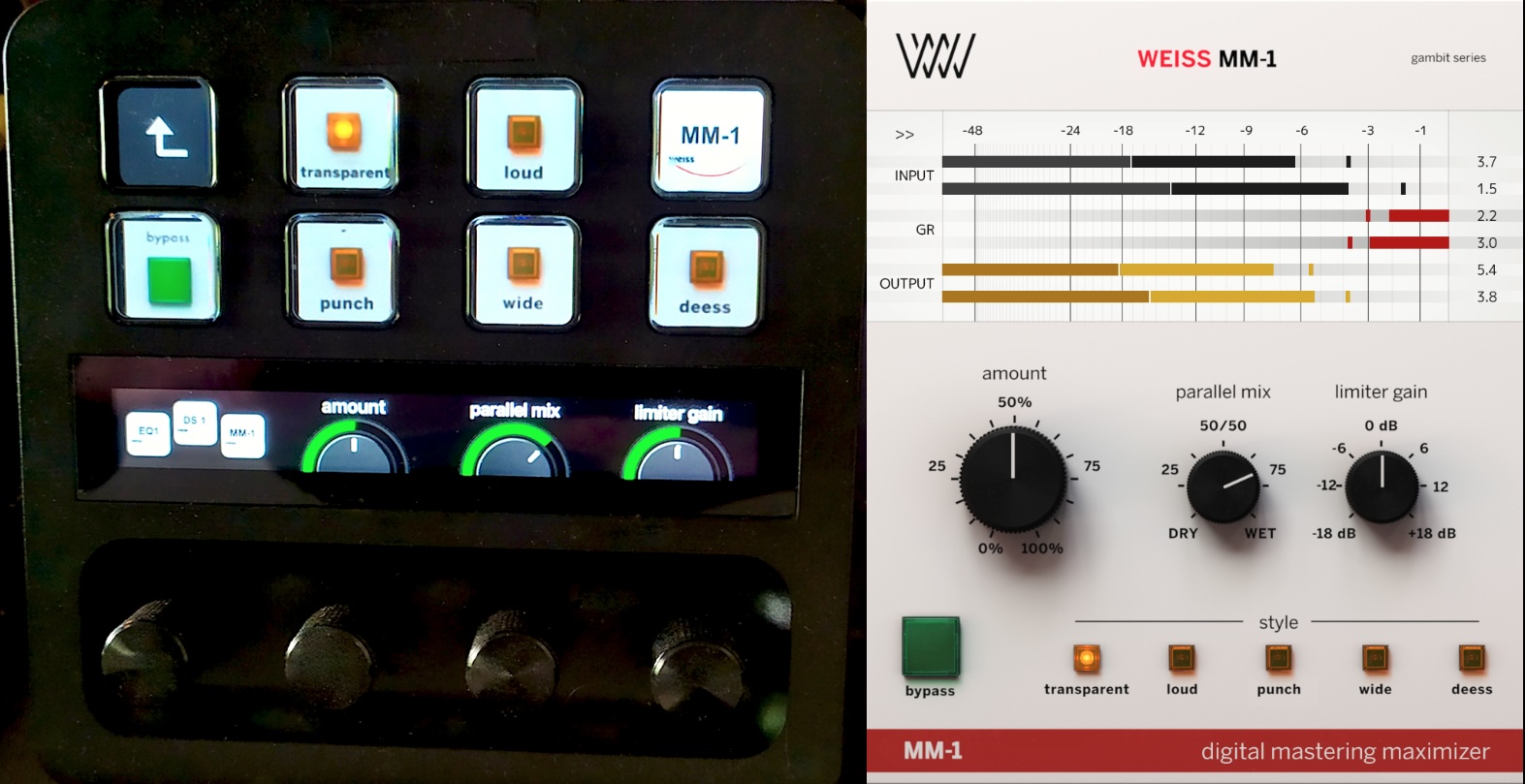 Being able to control the software externally is important to me because I want to be able to perform the main tasks without a mouse or trackpad. Unlike live performances, where I like to use an iPad as a controller, I definitely prefer rotary encoders for mastering. The Streamdeck+ has proven to be a really good choice for this. It has eight buttons that can be assigned with images (png/jpg) including two alternating images for the on/off state. It also has four rotary controls (encoders with quiet detents) that have a sophisticated push function. The dials can also be used as push buttons, but a dial function is also possible while pressed. Since the Weiss Mastering Maximizer has very few parameters, the controls can be easily displayed in one image. The Weiss EQ1 has a total of 171 parameters—I will probably need to add another controller for that. Finally, the Streamdeck+'s touch strip should also be mentioned, which in this case displays the positions of the dials and you can switch to the next or previous controller assignment by swiping.
Being able to control the software externally is important to me because I want to be able to perform the main tasks without a mouse or trackpad. Unlike live performances, where I like to use an iPad as a controller, I definitely prefer rotary encoders for mastering. The Streamdeck+ has proven to be a really good choice for this. It has eight buttons that can be assigned with images (png/jpg) including two alternating images for the on/off state. It also has four rotary controls (encoders with quiet detents) that have a sophisticated push function. The dials can also be used as push buttons, but a dial function is also possible while pressed. Since the Weiss Mastering Maximizer has very few parameters, the controls can be easily displayed in one image. The Weiss EQ1 has a total of 171 parameters—I will probably need to add another controller for that. Finally, the Streamdeck+'s touch strip should also be mentioned, which in this case displays the positions of the dials and you can switch to the next or previous controller assignment by swiping.
The Weiss-Software PlugIns are only suitable for editing and mastering, not for “live” use, as they have a similarly high latency as the Weiss hardware. For me, they are excellent as the final stage (in the software 2-bus) before going to the analog processors, but you can of course also use them as a complete mastering chain.
My Ideal Vision
Ever since I started working with the ULN-8 Audio-Interface from Metric Halo, I've had the desire of "rebuilding" a Mastering Chain mainly in the Audio Interface itself. For the missing details the "Building-Blocks" (MH-Console) could be of great benefit.  Meantime, I have been able to gain the experience that I simply lacked at the beginning of this idea and I now have a better view into exactly what I want to achieve.
Meantime, I have been able to gain the experience that I simply lacked at the beginning of this idea and I now have a better view into exactly what I want to achieve. 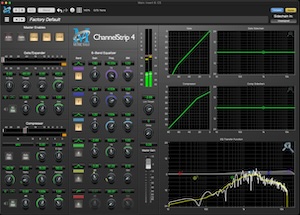 I still consider the Metric Halo PlugIns in the MH Console software to be significantly superior to AU or VST PlugIns. Just the Channelstrip is a gold standard for the mixing, it's wonderful to work with and it "feels analog"! Quite different from AU or VST PlugIns. The Console3d package is pretty much complete and comes quite close to the hardware in terms of working "feel". Truly a great challenge…
I still consider the Metric Halo PlugIns in the MH Console software to be significantly superior to AU or VST PlugIns. Just the Channelstrip is a gold standard for the mixing, it's wonderful to work with and it "feels analog"! Quite different from AU or VST PlugIns. The Console3d package is pretty much complete and comes quite close to the hardware in terms of working "feel". Truly a great challenge…
One problem for me is (unfortunately still) the external control of Console3d. As an alternative to the Eucon protocol, the 20-year-old MCP (Mackie Control Protocol) is also offered for control, but it is not 100% compatible with the newer “MCU” (Mackie Control Universal), which is now implemented by most manufacturers in their controllers (e.g., Presonus Faderport).
Sontec MES 432 D9D
Metric Halo is now boosting this idea tremendously, as the company has broken new ground and, together with Sontec and Make Believe Studios, has introduced a Mastering Equalizer for the Metric Halo hardware and integrated it into the Console3d software. I have not yet found enough time to really dig in, but am expecting something special and I am very excited.
In its 25 years of existence, Metric Halo has never disappointed with new releases and upgrades – quite the contrary! And the Sontec Mastering Equalizer (MES), designed by Burgess Macneal and George Massenburg and introduced in 1972, is not just another mastering equalizer – it has achieved almost mythical status (and the “historic” models sell for around $20,000). So I'm quite hopeful that this EQ and the new “State Space Model Extraction Process” technology could be a really big deal. In my opinion, BJ Buchalter, the technical mastermind behind MH, is a genius in the field of audio.

Click on the image for a complete view of the PlugIn including the Transfer function (with Spectrum Analyzer) and labels.
Metric Halo Text:
"Based on the MES-432D9 utilized by some of the most demanding engineers in the world, this equalizer needs no introduction. Thanks to Metric Halo's revolutionary new State Space Model Extraction Process this equalizer is available digitally in a way that is true to Burgess's vision for the first time.."
"This processor represents a bunch of new tech (MH State Space Model Extraction) we developed to faithfully capture the curves and character of the Burgess Macneal “blessed” MES-432D9 we used as the prototype for the modeling process.
While the MES-432 is an extremely pristine parametric equalizer, the analog characteristic of the EQ is complex and not directly representable with a standard digital EQ implementation. The MES-432D9D captures the complex analog shape of the filters and the interactions between the controls, even when running at 1x sample rates.
The extracted State Space Model reproduces the eq correctly, even for the HF bells when running at 1x sample rates (for example, it generates the correct in-band shape, even when the center frequency is at or above nyquist), without oversampling."
Already after my first experiences with this plug-in, my enthusiasm remains unbridled. Surprisingly, there are very few videos or online reviews available so far. However, most tests have been produced using interfaces from other manufacturers (i.e., “native”) rather than Metric Halo audio interfaces. I assume, however, that it sounds even better within the MH hardware—and in this segment (mastering), every little detail counts!
The upgrade to v2 has added an Options Panel, which can be used to switch the individual bands on and off and to activate a Mid-Side function!
I have the distinct feeling that the time has come for a “maximally minimized” mastering chain.
In the following video, the great master himself sums it up in a nutshell:
Burgess Macneal - The MES 432 D9D
Here is another (corresponding) excerpt of an original text written by George Massenburg
GM: "After I moved to Los Angeles in 1975 I redesigned the basic discrete op-amp. For all of the GML and Sontec designs (Burgess and I, among others, own the company jointly, though you'd never know it) I designed two significant revisions. The first had truly stupendous HF response; it featured a 2N5566 dual J-FET running at an ungodly high current, and a highly-linear second stage which featured the dominant pole. It was ridiculously fast (150mHz gain-bandwidth, 600v/us slew rate) and stable (no instability over a 60dB gain-variation range) as it was unreliable (from smoking to out-and-out explosions). We've long since gone to a fast, very-high-gain NPN input stage, keeping the high-voltage gain 2nd stage for GML designs, although the design evolves as semiconductor manufacturers obsolete discrete parts."
Bump Box (HS-2030)
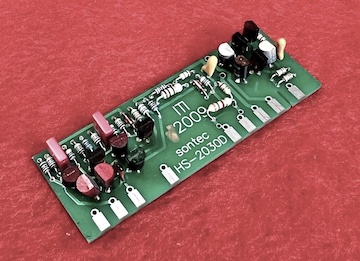 Burgess Macneal, the inventor of the Sontec, sums up everything that I tried to convey on this page within two and a half minutes in the video below. And he also mentions (as a special twist!) the "Missing Link" that will be following in the near future - the "Bump Box"! It is a simple stereo Line-In-Line-Out box containing the output stage of an MES Equalizer featuring the famous HS-2030 Amplifiers. These "super fast" HS-2030 Op-Amps provide a complement in the harmonic behavior that is not (yet) to be reproduced digitally in the same manner. The image shows an HS-2030 amp from 2009. The pictured board with 40 components (1 channel) is traded for around € 300. I do hope the Bump Box will not be too costly…
Burgess Macneal, the inventor of the Sontec, sums up everything that I tried to convey on this page within two and a half minutes in the video below. And he also mentions (as a special twist!) the "Missing Link" that will be following in the near future - the "Bump Box"! It is a simple stereo Line-In-Line-Out box containing the output stage of an MES Equalizer featuring the famous HS-2030 Amplifiers. These "super fast" HS-2030 Op-Amps provide a complement in the harmonic behavior that is not (yet) to be reproduced digitally in the same manner. The image shows an HS-2030 amp from 2009. The pictured board with 40 components (1 channel) is traded for around € 300. I do hope the Bump Box will not be too costly…
JML HS-3030. A DIY Alternative?
The HS-2030 from Sontec (ITI) is amongst Sontec EQ owners not entirely without controversy: varying components, heat, durability and in more recent times even the build quality (cold solder joints) are complained of. Some Sontec HS 2030 seem to alter over time and are then being replaced (but there are also statements about many years of use without any problems).  JML Audio is offering an HS3030 for $120.00. “A modern version of the Sontec HS2030, but with several improvements for a longer, reliable service life without any changes to the sound.” Sounds good to me—and sums up the known problems with the 2030. Might be an interesting DIY alternative if the Sontec Bump Box is too expensive (for me). So it would be helpful to find out the level of the mentioned “nominal gain” for the input of the HS-2030 (or HS-3030) – is it perhaps only the nominal levels of -10dB or +4dB? That could certainly be clarified.
JML Audio is offering an HS3030 for $120.00. “A modern version of the Sontec HS2030, but with several improvements for a longer, reliable service life without any changes to the sound.” Sounds good to me—and sums up the known problems with the 2030. Might be an interesting DIY alternative if the Sontec Bump Box is too expensive (for me). So it would be helpful to find out the level of the mentioned “nominal gain” for the input of the HS-2030 (or HS-3030) – is it perhaps only the nominal levels of -10dB or +4dB? That could certainly be clarified.
Unfortunately, I haven't heard anything more about the “Bump Box” mentioned above in the last two years, but according to Stefan Bahr (Metric Halo Germany), the ULN-8 MkIV amps are fast enough!
Conclusion
Such super-high-speed amps could actually be the “final touch” to my vision of extremely reduced hardware, and I am eagerly awaiting the upgrade of my ULN-8 to MkIV – now no longer mainly because of the low latency of 18 samples (for live electronics). With my limited technical understanding, I previously assumed that transformers were the only necessary hardware enhancement, but after hearing Burgess Macneal's statements and briefly familiarizing myself with the subject matter, I think the amps complete exactly what I was previously looking for exclusively in transformers. The analog components that, in my opinion, represent the difference between digital and analog could therefore be the transformers and (fast) op-amps.
The Neve Portico II Mastering Bus Processor with its transformers will of course remain part of my plans. For now, I will run the excellent-sounding MES-432D9D plug-in through the Master Bus Processor—and I'm already enjoying it immensely! Since the Master Bus Processor has parallel mix, compressor, stereo field editor, and limiter, it could already be the complete minimal solution for an OTB mastering chain for me. Even if the recording has better quality as a result, I still think that this only applies “to the full extent” when listening through the selected devices. Only a fraction of this quality will still be apparent on the finished recording.
I believe I have found an answer to the big question of why hardware (“live” / in operation) sounds “better” or more musical than when playing back the recording made from it:
For example, op-amps such as those discussed above generate harmonics far beyond our hearing range through square waves, which can exceed 200 kHz. However, high frequencies also have an effect on lower frequencies, and this is perhaps precisely why we perceive hardware as more “lively.” This physical aspect cannot (yet) be implemented in the digital world. And here again, the “annoying” Nyquist frequency is to blame.
The Nyquist frequency is half the sampling frequency (or sample rate). In order to accurately sample a signal, all components must therefore have frequencies lower than the Nyquist frequency. If the frequencies are higher, non-linear distortions occur. This is known as the aliasing effect.
So we get an incomplete representation of the recorded signals until this problem can be overcome (certainly also) by significantly higher sampling rates, preferably without oversampling and without the computer burning out. We therefore also have to record what we cannot hear. We have already made significant progress in terms of recording, but as long as recording or playback is still at 44.1 kHz or 96 kHz, we will have to wait a little longer. It is interesting to consider that loudspeakers do not need to be able to reproduce these high frequencies. The proof of this is that we can already hear the difference and our hearing threshold is just over 20 kHz anyway. These are therefore "internal frequency particles” that affect the entire structure of the signal and obviously also have an impact on the audible frequency range.
More about the gear and PlugIns in my studio can be found under Studio Hardware & Setup.

